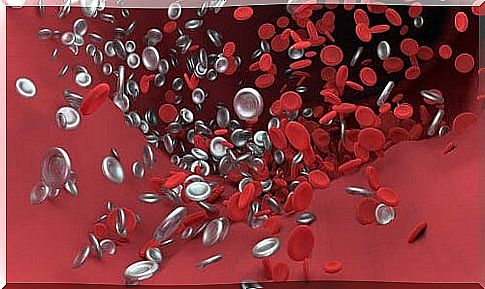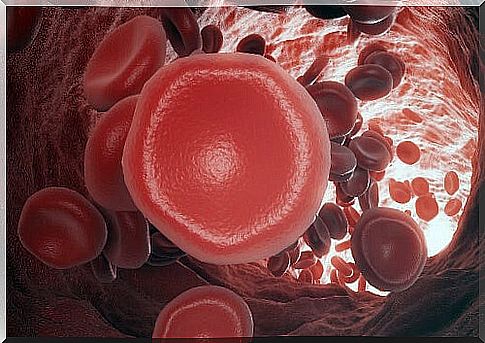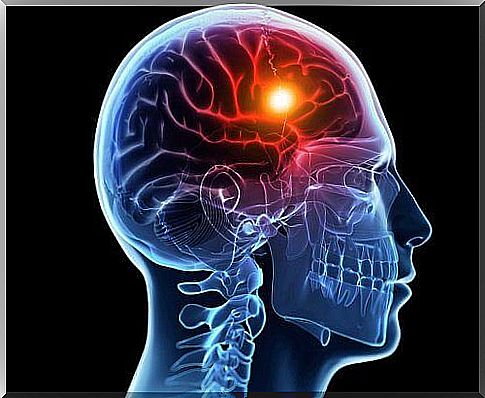Cerebral Embolism: What Is It And How Does It Manifest Itself?

A cerebral embolism is a type of cerebral infarction, that is, a stroke in which blood does not flow to the brain. Unfortunately, this is a very common pathology and a situation that requires immediate intervention.
Are you at risk of a cerebral embolism ? What are its symptoms and who can it occur? In this article, we’ll tell you everything you need to know about it.
What is a cerebral embolism?
As we mentioned before, a cerebral embolism is a type of cerebral infarction or stroke. This means that blood flow is interrupted in a blood vessel in the brain. As a consequence, the area of the brain that was served by this vessel stops receiving blood.
When tissue stops receiving blood, it also gets no oxygen or other nutrients because blood is responsible for transporting these substances. What happens next leads to serious problems. Well, cells that are part of this tissue first have difficulty continuing to perform their functions, and eventually die.

An embolism can be a blood clot that travels through the circulatory system until it reaches the brain. Different types of embolism are based on the production mechanism. According to this principle, a cerebral embolism arises, as its name implies, when the blockage of blood flow reaches a vessel in the brain.
This type of embolism can arise from various substances such as a clot of cells and blood molecules. The clot travels through the vessels until it reaches a point where, due to its size, it becomes blocked, preventing normal flow from then on.
Causes and types of cerebral embolism
We have already discussed that the substances from which a cerebral embolism can form are different. Here are some of the main types of blood clots and their causes:
- Clots: Formed by a clot that becomes thicker than normal blood. Its main cause is atrial fibrillation, which causes turbulent blood flow to the heart and the formation of clots. Prolonged immobilization, especially of the legs, after surgery or an accident, is also a factor that facilitates the appearance of blood clots.
- Air: This is an air bubble that prevents blood from flowing normally. It is formed when a certain amount of air enters a blood vessel. For example, when inserting a needle to withdraw blood.
- Fat: Fatty embolism occurs when a large amount of fat builds up in the blood as cholesterol.
For clarification, it should be said that the difference between a thrombus and an embolus is that the thrombus closes the vessel in the same place where it forms, without breaking away from the walls. The blockage, on the other hand, will move through the circulatory system until it gets stuck in some place. The causes and types of blood clots and emboli may therefore be of the same origin.
How does cerebral embolism affect the body and what are its symptoms?
The brain is the organ in our body that is most sensitive to blood flow. This is because it is made up of many cells – neurons – that constantly require large amounts of oxygen. Disruption of blood flow in this area causes brain tissue to atrophy and die within minutes.
The symptoms of a cerebral embolism come on suddenly. There are also cases where they gradually appear over the course of a few hours, but such situations are much less frequent.
Symptoms will depend on the blood vessel that has clogged and the area and part of the brain that feeds it. Some of the most common symptoms of a cerebral embolism include:
- Headache
- Weakness or loss of feeling in one or more limbs or one half of the body
- Sudden trouble speaking or understanding
- Lack of motor coordination when walking
- Dizziness or nausea
- Loss of sight in one or both eyes.
Diagnosis and treatment
Cerebral embolism is a situation that requires immediate medical attention. This is because the longer an area of the brain is left without a blood supply, the more tissues will die and the consequences will be more severe and irreversible. In this situation, the key is to quickly recognize the symptoms and call an ambulance.

When an alarm sequence is triggered, healthcare professionals will be responsible for assessing the patient’s condition. If necessary, tests, such as a CT scan, will be performed to confirm that it is a stroke and classify it as one of the types.
Once the type of cerebral ischemia is established, the speed with which treatment is started will be important. In the event of an embolism, drugs that dissolve the embolism can be used. Or, surgery can be performed to remove it.
This will depend on the type and location of the embolus, however, only specialist physicians can choose the treatment that best suits each case.
Cerebral embolism is a condition that requires immediate intervention
Unfortunately, this pathology occurs quite often and requires immediate medical intervention. On our part, it will be necessary to recognize the symptoms and warning signs in order to notify the emergency services.
From the moment the ambulance arrives, paramedics will in each case decide on the most appropriate steps.
However, we must remember that it will not always be possible to recover all functions lost after a cerebral embolism. Rehabilitation will be required and may be shorter or longer depending on the individual case.









